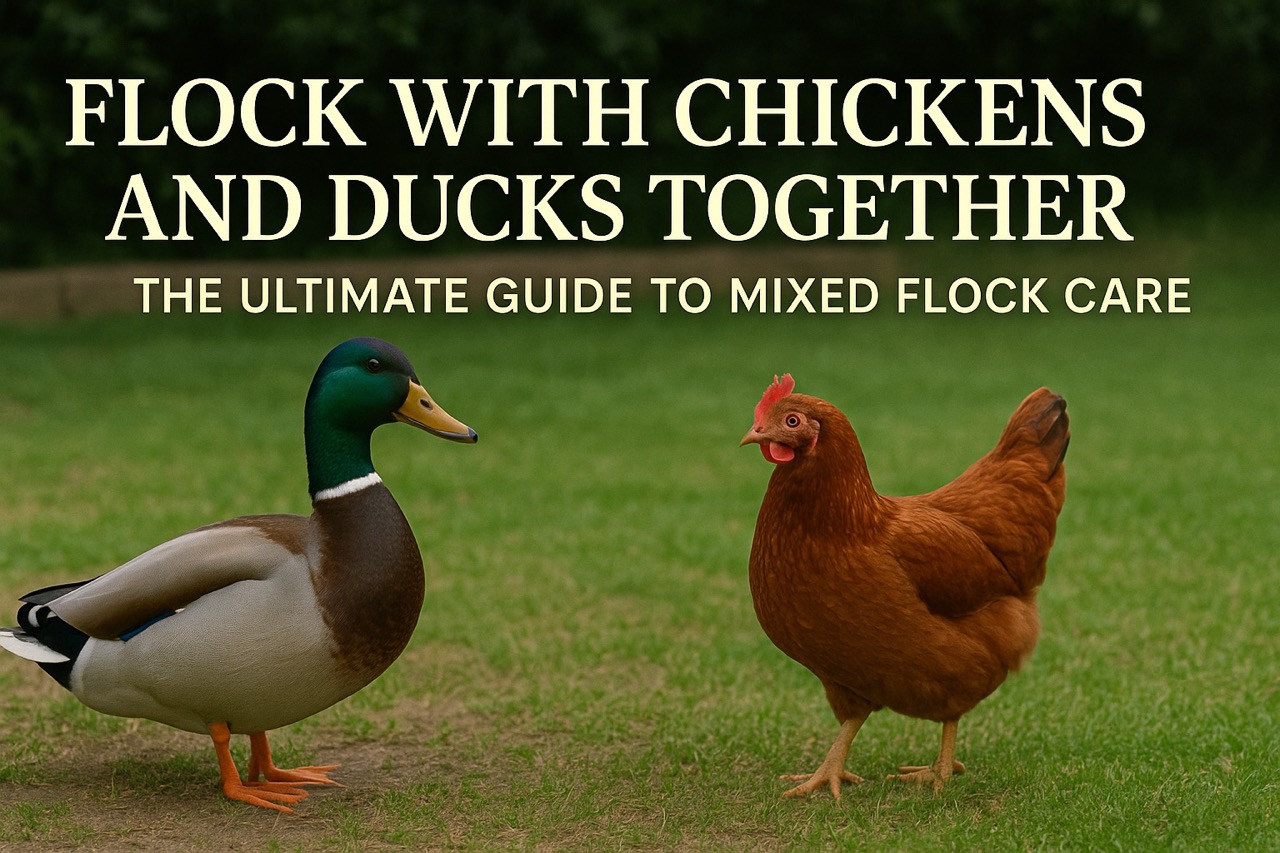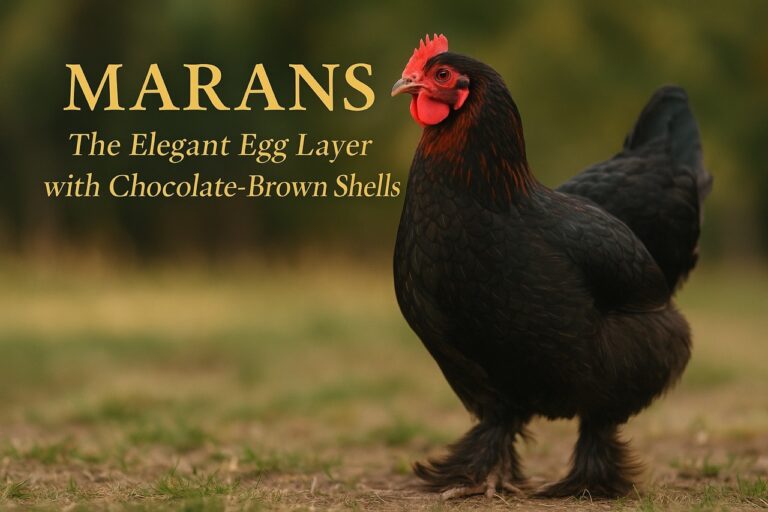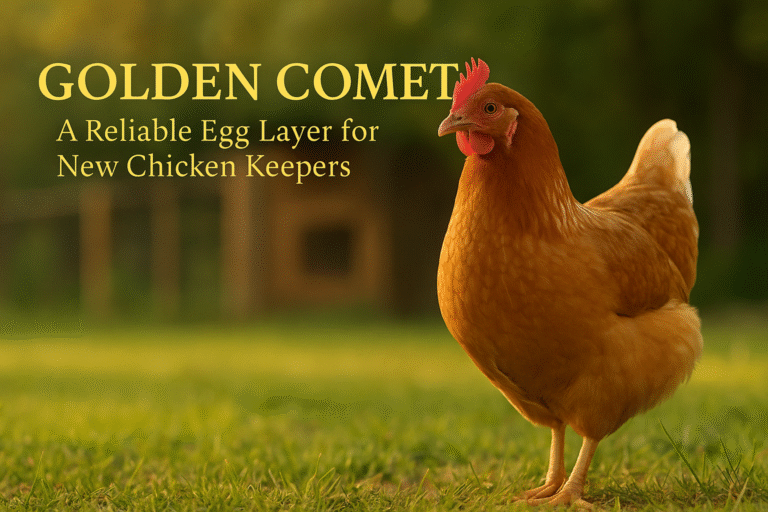Raising chickens and ducks together in a shared backyard flock can be both productive and fulfilling. Ducks bring natural pest control and water-loving joy, while chickens offer efficient foraging and egg-laying with minimal mess. Together, they form a powerful team—if you manage their unique needs carefully.
This comprehensive guide covers everything you need to build a safe, functional, and peaceful home for your mixed flock. From water management and housing to feeding, behavior, enrichment, and seasonal care, here’s how to help your chickens and ducks thrive together.
🐔 Can Chickens and Ducks Live Together?
Yes—but only if you meet the needs of both species. Chickens prefer dry conditions, elevated roosts, and private nest boxes. Ducks, on the other hand, enjoy wet areas, ground-level sleeping, and access to water deep enough for cleaning.
To make it work:
- Provide roosts for chickens and ground bedding for ducks
- Keep water areas outside the coop
- Plan for plenty of space and minimize competition
When done right, chickens and ducks can live together in harmony and improve each other’s environment.
🚰 Water Management for a Mixed Flock
Water is the biggest challenge in a mixed flock setup.
Ducks Need:
- Deep water to dunk their heads (prevents sinus and eye infections)
- Areas to splash and clean themselves
Chickens Need:
- Dry conditions to avoid respiratory problems
- Shallow, spill-proof waterers
Tips for Success:
- Place duck water outside the coop
- Use drainage bases or gravel to reduce mud
- Provide separate waterers for ducks and chickens
- Use heated bowls or de-icers in winter
A designated “wet zone” keeps ducks happy without endangering your chickens.
🏠 Housing Chickens and Ducks Together
Design your coop and run to serve both species comfortably.
Coop Space Needs:
- Chickens: 4 sq ft per bird indoors
- Ducks: 6 sq ft per bird indoors
Run Space:
- Minimum 10 sq ft per bird outside
Sleeping Arrangements:
- Chickens: Raised roosting bars
- Ducks: Soft ground-level bedding
Nesting Areas:
- Chickens: Elevated nest boxes (12-18 in high)
- Ducks: Ground-level nest areas with deep bedding
Climate Adjustments:
- Winter: Insulate coop, block drafts, add extra bedding
- Summer: Increase ventilation, provide shade, give ducks water access
🌽 Feeding a Mixed Flock
Chickens and ducks have similar diets with a few key differences.
Feed Strategy:
- Use all-flock feed for both species
- Supplement ducks with niacin (brewer’s yeast or peas)
Feeding Setup:
- Chickens: Elevated feeders
- Ducks: Ground-level feeders, away from water
Keep food areas separate and dry to prevent mold and competition.
💉 Health & Hygiene in a Mixed Flock
Ventilation:
- Ducks bring moisture—vent high to release humidity
- Avoid drafts at duck-level
Cleanliness:
- Remove wet bedding daily
- Use absorbent materials like straw or pine shavings
- Deep clean every 2–3 weeks
Parasite Prevention:
- Use diatomaceous earth in bedding
- Inspect flock weekly for lice, mites, or irritation
📊 Behavior & Flock Dynamics
Pecking Order:
- Chickens may dominate
- Ducks are generally docile
Tip: Introduce new birds slowly and monitor interactions
Sleeping Needs:
- Chickens need dark, quiet perches
- Ducks stay active longer and need quiet ground zones
Aggressive Drakes:
- Keep at least 3-4 ducks per drake
- Separate aggressive males during mating season
🌳 Outdoor Enrichment & Space
Pest Control:
- Ducks = slug and snail control
- Chickens = bug and grub hunters
Run Ideas:
- Add a kiddie pool for ducks
- Provide dust baths for chickens
- Create shaded foraging zones
Seasonal Tips:
- Summer: Ice treats, misters, frozen fruit
- Winter: Scatter-feed in straw, hanging veggies, activity trays
🏡 Building a Thriving Mixed Flock
With thoughtful care, a mixed flock of chickens and ducks can bring joy, eggs, pest control, and beautiful variety to your backyard. Plan your setup around their differences—not despite them—and you’ll foster peace, productivity, and a more natural homestead.
Want a visual overview? Watch a quick explainer here: https://www.youtube.com/watch?v=Tw5lyfLQSLw
🔗 Further Reading on Paranoid Prophet
- 🦆 Managing Drakes and Chickens in a Mixed Flock
Learn how to prevent injuries and stress when male ducks and hens share space — including drake behavior during mating season. - 🏡 Optimal Chicken Feeder Placement
Reduce waste, mess, and health risks with the best feeder elevation techniques for mixed flocks. - 🐓 How Many Chickens to Start With
Understand minimum social needs, space planning, and coop layout tips before combining flocks. - 💦 Backyard Chickens and Ethical Living
Explore the spiritual and ethical dimensions of caring for chickens and ducks in harmony with creation. - 🧼 Chicken Dust Bath Guide
Essential care info to help chickens maintain hygiene — especially important when sharing space with splash-loving ducks. - ✝️ Sacred Stewardship with Backyard Chickens
A reflection on how caring for your flock is a spiritual act of dominion done right — with practical insights woven in.
Sources
- “Raising Chickens and Ducks Together: The Complete Guide” – Know Your Chickens
- Description: This comprehensive guide explores the nuances of keeping chickens and ducks in the same flock, addressing differences in water needs, feeding habits, and sleeping arrangements. It offers practical advice on managing their distinct behaviors to ensure a harmonious coexistence.
- Link: https://www.knowyourchickens.com/chickens-and-ducks-together/
- “Keeping Ducks and Chickens Together: Your Ultimate Guide” – Raising Ducks
- Description: This article delves into the practical aspects of housing ducks and chickens together, including coop design, feeding strategies, and health considerations. It emphasizes the importance of accommodating each species’ unique needs to maintain a healthy and happy mixed flock.
- Link: https://www.raising-ducks.com/keeping-ducks-and-chickens-together/
- “What You Should Know About Raising Chickens and Ducks Together” – The Happy Chicken Coop
- Description: This resource highlights the key differences between chickens and ducks, particularly regarding their water requirements and behaviors. It provides insights into how to modify coops and equipment to suit both species, ensuring a comfortable environment for all.
- Link: https://www.thehappychickencoop.com/what-you-should-know-about-raising-chickens-and-ducks-together/
- “7 Tips for Raising Ducks with Chickens” – Chickens and More
- Description: Offering practical tips, this article covers essential topics such as coop setup, feeding routines, and managing common health issues in a mixed flock. It aims to help poultry keepers create a harmonious environment where both chickens and ducks can thrive together.
- Link: https://www.chickensandmore.com/raising-ducks-with-chickens/
FAQ | Flock with Chickens and Ducks Together
General Mixed Flock Questions
- Can chickens and ducks live together in the same coop?
Yes, chickens and ducks can live together, but their distinct needs for space, water, and nesting require careful planning to ensure harmony. - What are the benefits of raising a mixed flock of chickens and ducks?
A mixed flock provides diverse eggs, improved pest control, and complementary behaviors that make them great backyard companions. - How do I introduce ducks to an existing flock of chickens?
Introduce ducks gradually by placing them in separate but adjacent spaces for a few days. Monitor interactions before allowing full integration.
Housing and Environment
- How much space do chickens and ducks need in the coop?
Chickens need about 4 square feet per bird inside the coop, while ducks require 6 square feet each. Outdoor runs should provide at least 10 square feet per bird. - Do ducks need a pond to live with chickens?
No, ducks don’t need a pond, but they do require water deep enough to dunk their heads. A kiddie pool or small tub is sufficient. - How do I keep the coop dry when housing chickens and ducks together?
Place duck waterers outside the coop, use drainage platforms, and clean damp bedding frequently to maintain a dry environment.
Feeding and Nutrition
- Can chickens and ducks eat the same feed?
Yes, they can eat all-flock feed, but ducks need additional niacin for healthy growth, which can be supplemented with brewer’s yeast. - What treats are safe for both chickens and ducks?
Both species can enjoy peas, leafy greens, grains, and mealworms. Avoid foods high in salt or sugar, and ensure treats are evenly distributed. - Do ducks and chickens need separate feeders?
Separate feeders are recommended, as ducks are messier eaters. Elevate chicken feeders and provide ground-level feeders for ducks.
Water Management
- Why do ducks need deeper water than chickens?
Ducks need deep water to clean their eyes and nostrils, which prevents infections and maintains healthy feathers. - How do I stop ducks from making the coop too wet?
Place their water source outside the coop, use drainage platforms, and provide separate areas for splashing, like a kiddie pool. - Can ducks and chickens drink the same water?
It’s better to provide separate water sources. Ducks need deeper water, while chickens prefer shallow, controlled waterers to avoid getting wet.
Health and Behavior
- What are common health concerns for a mixed flock?
Respiratory issues in chickens due to damp conditions, niacin deficiencies in ducks, and parasite infestations are common concerns. - How do I manage aggressive behavior in a mixed flock?
Provide ample space and resources to reduce competition. If a drake becomes aggressive, separate him from the flock during breeding season. - Do chickens and ducks get along naturally?
Chickens and ducks can coexist peacefully, but their social behaviors differ. Ducks are less likely to peck, while chickens may assert dominance.




